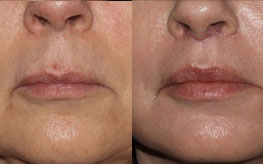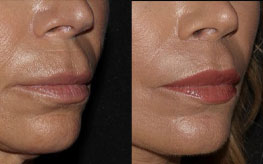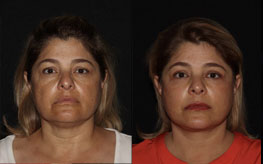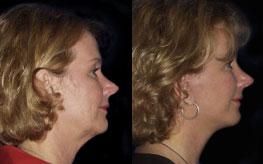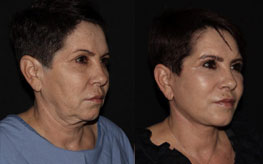Brow Lift
Conveniently located to serve the areas of San Diego, CA

The appearance of the brow can greatly affect the appearance of the entire face. Eyebrows that are naturally low or have descended with aging can make the eyes look heavy or tired. Wrinkles of the forehead can make you look older, and frown lines can make you look angry, even when you are not.
Also known as a forehead lift, a brow lift minimizes the creases that develop across the forehead, or those that occur high on the bridge of the nose; improves what are commonly referred to as frown lines; and repositions a low or sagging brow.
If you are bothered by expression lines or other signs of aging in the brow, a brow lift may be right for you. A brow lift:
- Minimizes the creases that develop across the forehead, or those that occur high on the bridge of the nose, between the eyes
- Improves what are commonly referred to as frown lines, vertical creases that develop between the eyebrows
- Repositions a low or sagging brow that is hooding the upper eyelid
- Raises the eyebrows to a more alert and youthful position
- Tightens loose skin lateral to the eyes
Brow lifts are often combined with upper eyelid surgery to gives a rejuvenated appearance to the surrounding area of your eyes, making you look more rested and alert.
For more information about our brow lift surgery procedure, please contact us online or call us at 888-463-9532. We look forward to helping you look your best.
Contents
Before and After Photos
Understanding the Brow Lift Procedure
At Alexander Cosmetic Surgery, the Brow Lift is one of the procedures we commonly perform for facial rejuvenation. Dr. Alexander and Dr. Kaplan trained in endoscopic (minimally invasive) procedures when the technology was in its infancy and became very skilled at the procedure, performing over 50 such procedures in his first year of practice.
Most patients are pretty satisfied with how they look, they’re just not happy with the changes of age. Patients don’t want to look different, or changed, just fresher and younger. Most just want to turn back the clock several years. Many patients comment that they look older than they feel, but are wary of cosmetic eyelid surgery, especially if they’ve seen poor outcomes in others. We often hear, “I don’t want to look funny, or surprised.”

We have all seen celebrities, friends, or people on the street with an overdone, surprised surgical look. You will be relieved to know that this “look” can easily be avoided, and does not happen accidentally. This unnatural look is usually caused by a couple of avoidable issues.
First, when patients receive a consultation for heavy upper eyelid skin, plastic surgeons too often recommend, and perform, brow lifts in conjunction with upper eyelid surgery because a brow lift is also successful in removing unwanted eyelid skin. However, this can frequently result in a brow that is too elevated and unnatural. This procedure can artificially create a rounded, hollow look to the orbital area actually making a patient look older.
A WORD OF CAUTION: The brow lift is probably the most over-recommended procedure by plastic surgeons. When performed on a patient who doesn’t need it, it risks giving the face an unnatural, surgical look. When you see a person who has obviously had overdone eyelid surgery and has that surprised look, a brow lift is most likely the culprit.
In our practice we are careful to recommend brow lifts only for patients who have very obvious indications for requiring one. Often, eyelid surgery, which is simpler and less expensive, is all that is required to improve the upper eyelid area.
Procedures often performed in conjunction with a brow lift to rejuvenate the face are QuickLift™, eyelid lift, chemical or laser peels to smooth wrinkles, frown lines and sun-damaged skin, and fillers, such as your own fat to fill deep lines. BOTOX® is also used to relax forehead lines.
Before You Decide…
The Consultation
To ensure the most natural looking-results, it’s imperative for a surgeon to recommend the procedure which most appropriately matches your needs and to offer realistic expectations for post-surgery outcomes. When you meet with a surgeon, you should expect a full discussion of the surgically appropriate options for your face, which is uniquely yours.
A good surgeon will go through a series of examinations and observations that are individual and dependent upon your specific situation and goals. Also factored into this process are the doctor’s expertise, training, and experience. If a surgeon specializes in a particular type of brow lift procedure, don’t be surprised if it is recommended over other options. Be wary of the “one-size-fits-all” approach. This is particularly important because, as medicine continues to advance, patients have more options made available to them.
The success of your brow lift depends very much on your complete candidness during your consultation. We will ask you questions about your health, desires, and lifestyle.
Be prepared to discuss:
- Why you want the surgery, your expectations, and desired outcome
- The options available to you for facial rejuvenation
- Medical conditions, drug allergies, and medical treatments
- Use of current medications, vitamins, herbal supplements, alcohol, tobacco, and drugs
- Previous surgeries
We may also:
- Examine and measure your face.
- Take digital photographs for computer imaging
- Discuss your options and recommend a course of treatment
- Discuss likely outcomes of a brow lift and any risks or potential complications
- Discuss the anesthesia options available
Other procedures can further enhance the outcome of a Brow Lift. They include:
- Eyelid surgery to rejuvenate the eyes
- Resurfacing techniques to improve the tone and texture of forehead skin
- Fat transplantation to the frown lines
Who is a good candidate?
Brow lift surgery is usually performed on adult men and women who have healthy facial tissue and muscles and have realistic goals for improvement of the brow.
A Brow Lift may be a good option for you if:
- You are healthy and do not have a life-threatening illness or medical conditions that will impair healing
- You have a positive outlook and specific goals in mind for brow surgery
- You do not have serious eye conditions
- You look tired or angry even when you are not
- You tend to frown when you are concentrating
- You have frown lines or deep creases in the forehead
You should tell us if you have any of the following medical conditions:
- Glaucoma
- Dry eyes
- Graves’ disease or any other thyroid disorder
- Cardiovascular disease, high blood pressure, or other circulatory disorders
But because every case is unique, the only way to accurately determine which procedure is best for you is to consult with Dr. Alexander and Dr. Kaplan. Also, there are many options to rejuvenate the structures around the eye, making the eye look younger and more rested.
What does it cost?
Cost is always an important consideration in elective surgery. However, when choosing a plastic surgeon for a Brow Lift, remember that the surgeon’s experience and your comfort are just as important as the final cost.
A quote will be provided to you after your consult with Dr. Alexander and Dr. Kaplan. Be sure to ask about our patient financing plans.
Cost may include:
- Surgeon’s fee
- Operating room and supplies
- Prescriptions for medication
- Medical tests
- Anesthesia fees
To learn more about our partner in payment plans, please visit CareCredit.
The Brow Lift Procedure
Prior to surgery, we will have you:
- Take certain medications or adjust your current medications
- Avoid taking aspirin, anti-inflammatory drugs, and herbal supplements as they can increase bleeding
- Stop smoking well in advance of surgery
During a preoperative appointment, usually 1-2 weeks before surgery, we will:
- Get lab testing or a medical evaluation
- Tell you what to do on the night before and morning of surgery
- Discuss the use of anesthesia during your procedure
- Explain post-operative care and follow-up as well as what help you will need after the procedure
Anesthesia
Medications are administered for your comfort during the surgical procedure. The choices include local anesthesia, intravenous sedation, and general anesthesia. We will recommend the best choice for you based on your personality, your desires, and the complexity of your procedure.
How We Do It: Tutorial
There are several methods to raise the eyebrows and weaken the muscles that cause frowning:
Coronal (Open) Brow Lift—This requires an incision all of the way across the top of the head, which takes more time and can also cause with more bleeding, scarring, hair loss, and numbness. It is not performed very often, and usually only by surgeons who have not become adept at the endoscopic technique.
Endoscopic (Closed) Brow Lift—Using several small incisions, a video camera is inserted allowing Dr. Alexander and Dr. Kaplan to gently loosen the brow tissues. The forehead is rotated up and secured into place. The procedure is quicker and essentially causes no scarring, blood loss, or numbness.
Direct Brow Lift—Occasionally it is very effective to remove a small ellipse of skin above each eyebrow. This is most commonly done in men who have lost hair.
Anterior Direct Brow Lift—This is done for patients—usually women—who already have a very tall forehead, and who risk increasing the length of the forehead with a standard technique. By making an incision across the front of the hairline, the brow can be lifted and excess forehead skin removed at the same time.
An Endoscopic Brow Lift typically takes about 40-60 minutes to perform, depending on the individual face and certain surgical variables.
There are five basic steps to the procedure.
Step 1 – Incision
Three to five 1 cm incisions are made at the hairline.
Step 2 – Loosening
After a small camera is inserted, surgical instruments are used to free the brow tissue, making it more mobile.
Step 3 – Myectomy (muscle separation and removal)
The corrugator muscles that cause frowning are divided and partially removed to create a smoother brow.
Step 4 – Fixation
The brow is elevated and secured at an elevated level, providing a lift to the eyebrows. Brow elevation may be maintained by the use of one of the following:
Permanent or temporary sutures
Tiny surgical screws
An absorbable fixation device placed inconspicuously at the temple
Step 5 – Closure
Small sutures are used to close the incisions, and a soft, compressive dressing is placed.
Informed Consent
Pain from the brow surgery is usually minimal. Occasionally, patients have a headache that can last overnight. Pain pills are provided but are usually not required after the first couple of days. Significant pain is extremely rare.
The decision to have a brow lift is extremely personal, and you will have to decide if the benefits will achieve your goals and if the risks are acceptable.
We will explain in detail the risks associated with surgery. You will be asked to sign consent forms to ensure that you fully understand the procedure you will undergo and any risks and potential complications.
The risks include:
- Temporary muscle weakness
- Temporary numbness of the forehead
- Changes in skin sensation
- Eye irritation or dryness
- Possibility of revisional surgery
It is very important to ask our surgeons questions about your procedure. It is natural to feel some anxiety beforehand, whether it’s excitement for your anticipated new look or a bit of preoperative stress. Don’t be shy about discussing these feelings with us.
Important Terms to Know
Anesthesia—General: The patient is asleep, requiring that the airway be protected either by a standard breathing tube or by a laryngeal mask (LMA), an inflatable mask that is placed in the back of the throat but not down the trachea. An anesthesiologist releases gases through the airway which put the patient asleep. Drugs may also be given through the IV.
Anesthesia—Local: The surgical area is numbed up with an injection, but the patient is awake. Sometimes a patient will be given an oral medication, like Valium, to help with relaxation.
Anesthesia— Sedation (Twilight): The patient is made sleepy with medications given through an IV. The level of sedation can be adjusted, from barely sleepy to very sleepy. Occasionally sedation is given by the surgeon, but most of the time it is administered by an M.D. anesthesiologist.
Blepharoplasty: Eyelid surgery to improve the appearance of upper eyelids, lower eyelids or both.
Brow Lift: A surgical procedure to correct a low-positioned or sagging brow. It smoothes furrows across the forehead and between the brows.
Endoscope: A surgical video device sometimes used during brow lift procedures.
Skin Resurfacing: Treatment to improve the texture, clarity, and overall appearance of your skin.
Recovery
Although our society is increasingly geared toward instant gratification, rushing the healing process is never a good idea. It’s easy for patients to get a little too active too quickly. The body has its own pace, and your body’s recovery speed is unique to you. As with any procedure, we have specific guidelines for preparation and recovery.
Recovery times vary from patient to patient. Brow Lift recovery tends to take about 4-10 days, with the average patient looking very good at about one week. Bear in mind, however, that these are averages. Some individuals may heal more quickly, while others may take longer to fully recover. A patient who tends to have more bruising and swelling than normal will take longer to heal.
Most patients should allow one week before returning to work and other normal day-to-day activities and about two weeks before participating in any kind of exercise or strenuous physical activity.
The Specifics
Following our instructions regarding medications and other post-operative measures is the key to a quick recovery. Herbal medications are available to reduce swelling and bruising and to speed the healing process.
It is important that the surgical incisions are not subjected to excessive force, abrasion, or motion during the time of healing. Avoid wearing any clothing that must go over your head. We will give you specific instructions on how to care for yourself.
You will need someone to drive you to and from surgery and to stay with you for at least the first night following surgery.
After your procedure is complete, your head will be snugly wrapped to minimize swelling and bruising. It is normal for the head to feel tight. Although a bandage is not absolutely necessary, it greatly decreases swelling and speeds your recovery time. It will also be a reminder to take it easy for the first day. If you become claustrophobic or uncomfortable, the bandage can be removed at any time. Cold compresses are then applied for the first 48 hours.
You will be given specific instructions that include:
- How to care for the surgical site
- Medications to apply or take orally to aid healing and reduce the potential for infection
- Specific concerns to look for at the surgical site or in overall health
- When to return to the office
We will see you the day after surgery, on the 4th or 5th day to remove your sutures, and then again at 7-10 days. At one week you can resume normal activities, at two weeks you can begin light exercise, and at three weeks there are no restrictions.
Results
The results of brow lift surgery will appear immediately. It is not uncommon for the brow to appear to be a little too high, but this is done because it will naturally settle with time.
It’s natural to feel impatient about seeing the “new” you, but you’ll need to be patient as your face heals from the surgery. Your final results will appear in 2-3 weeks. Once healed, the incision lines from a brow lift are invisible in almost all patients.
Because we have worked with so many patients, we can look at someone relatively early in their recovery and say, “You look great,” even though that patient can only see how they look that day — not how they will look a few weeks later. Your final result should not only restore a more youthful and rested appearance, but also help you feel more confident about yourself.
If our patients tell us they’re receiving a lot of compliments, but nobody knows they’ve had surgery, we feel like we’ve achieved our goal. And one of the ways we do this is by keeping things very simple and conservative. Some surgeons overplay their artistic ability and make recommendations that really change a person’s eyes and make them look quite a bit different than they used to. However, our goal is not to change a person’s appearance but to give them their best self.

